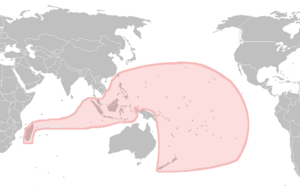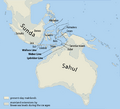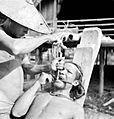Austronesian peoples facts for kids
Austronesian peoples are a large group of people who live in many parts of the world. You can find them in Southeast Asia, Oceania, and even Madagascar. These people share a common history and culture. They also speak languages from the Austronesian language family. Scientists believe their ancestors originally came from Taiwan.
Contents
Who Are the Austronesian Peoples?
The term "Austronesian" refers to a huge family of languages. It also describes the people who speak them. This group includes many different ethnic groups. They are spread across a vast area. This area stretches from Easter Island in the east to Madagascar in the west.
Where Do They Live?
Austronesian peoples live in many island nations. These include countries like Indonesia, Philippines, Malaysia, Brunei, and East Timor. They also live in Polynesia, Melanesia, and Micronesia. These regions are part of Oceania. In Southeast Asia, they are found in places like Singapore and parts of Vietnam and Thailand. The Malagasy people of Madagascar are also Austronesian.
The Great Austronesian Migration
One of the most amazing things about Austronesian peoples is their history of migration. About 5,000 years ago, their ancestors began to leave Taiwan. They used advanced canoes and sailing skills. These brave explorers sailed across vast oceans.
Sailing Across the Seas
They were incredible navigators. They used the stars, winds, and ocean currents to find their way. They settled new islands step by step. This journey took thousands of years. They reached the Philippines first, then Indonesia and Malaysia. Later, they sailed into the wide Pacific Ocean.
Settling Distant Islands
Their voyages led them to remote islands. They reached Hawaii, New Zealand, and Easter Island. This was a huge achievement in human history. They carried plants and animals with them. These included coconuts, taro, and chickens. This helped them start new lives on distant islands.
Austronesian Languages
The Austronesian language family is one of the largest in the world. It has over 1,200 different languages. This shows how widespread these people became. Even though they are far apart, many of these languages share similar words. This is proof of their shared origin.
Language Groups
The languages are divided into several main branches. The Formosan languages are spoken by the indigenous peoples of Taiwan. These are the oldest branches. All other Austronesian languages are called Malayo-Polynesian languages. They spread from Taiwan to the rest of the world.
Culture and Innovations
Austronesian peoples developed unique cultures. Their island homes shaped their way of life. They were skilled farmers, fishers, and builders.
Maritime Culture
Sailing and the sea were central to their lives. They invented the outrigger canoe and the catamaran. These boats allowed them to travel long distances. They also developed special navigation techniques. Their knowledge of the ocean was unmatched for centuries.
Traditional Houses
Many Austronesian groups built special houses. These often had raised floors. This protected them from floods and animals. Examples include the Bahay kubo in the Philippines. The Tongkonan houses of the Toraja people in Indonesia are also famous. They have distinctive saddle-shaped roofs.
Art and Crafts
Austronesian art is rich and varied. It includes intricate carvings, weaving, and tattooing. They often used natural materials. Wood, stone, and plant fibers were common. Their art often tells stories of their ancestors and myths.
Images for kids
-
Skulls representing Johann Friedrich Blumenbach's "five races" in De Generis Humani Varietate Nativa (1795). The Tahitian skull labelled "O-taheitae" represented what he called the "Malay race"
-
The New Physiognomy map (1889) printed by the Fowler & Wells Company depicting Johann Friedrich Blumenbach's five human races. The region inhabited by the "Malay race" is shown enclosed in dotted lines. Like in most 19th century sources, Islander Melanesians are excluded. Taiwan, which was annexed by the Qing Dynasty in the 17th century is also excluded.
-
Distribution of the Austronesian languages (Blust, 1999)
-
Paraw sailboats from Boracay, Philippines. Outrigger canoes and crab claw sails are hallmarks of the Austronesian maritime culture.
-
Coconuts in Rangiroa island in the Tuamotus, French Polynesia, a typical island landscape in Austronesia. Coconuts are native to tropical Asia, and were spread as canoe plants to the Pacific Islands and Madagascar by Austronesians.
-
Samoan man carrying two containers over his shoulder
-
The Javanese people of Indonesia are the largest Austronesian ethnic group.
-
Coastlines of Island Southeast Asia, New Guinea, and Australia during the last glacial period
-
Aeta fishermen in an outrigger canoe in Luzon, Philippines (c. 1899)
-
Possible language family homelands and the spread of rice into Southeast Asia (ca. 5,500–2,500 BP). The approximate coastlines during the early Holocene are shown in lighter blue.
-
Yue statue of a tattooed Baiyue man in the Zhejiang Provincial Museum (c. 3rd century BCE)
-
Proposed routes of Austroasiatic and Austronesian migrations into Indonesia (Simanjuntak, 2017)
-
Proposed genesis of Daic languages and their relation with Austronesians (Blench, 2018)
-
Colorized photograph of a Tsou warrior from Taiwan wearing traditional clothing (pre-World War II)
-
Queen [[Liliʻuokalani]], the last sovereign monarch of the Kingdom of Hawaii
-
Austronesian proto-historic and historic maritime trade network in the Indian Ocean
-
The raised bale houses of the Ifugao people with capped house posts are believed to be derived from the designs of traditional granaries
-
Tongkonan houses of the Toraja people with the distinctive saddleback roofs reminiscent of boats
-
Māori pataka storehouses
-
Cast of a Lapita red-slipped earthenware shard from the Santa Cruz Islands (c. 1000 BCE), showing dentate-stamped, circle-stamped, and cross-in-circle decorations. The latter two are shared elements from Neolithic red-slipped pottery from the Nagsabaran Site in the Philippines.
-
Māori hei matau jade pendant
-
Hand stencils in the "Tree of Life" cave painting in Gua Tewet, Kalimantan, Indonesia
-
Watu Molindo ("the entertainer stone"), one of the megaliths in Bada Valley, Central Sulawesi, Indonesia, usually found near megalithic stone vats known as kalamba.
-
Boats and human figures in a cave painting in the Niah National Park of Sarawak, Malaysia; an example of the Austronesian Painting Traditions (APT)
-
Petroglyphs in Vanuatu with the concentric circles and swirling designs characteristic of the Austronesian Engraving Style (AES)
-
Haligi pillars from the Latte period of Guam, these served as supports for raised buildings
-
A rai stone, large stone discs used as currency in Yap
-
A marae sacred site in Raiatea, French Polynesia
-
Hawaiian petroglyph depicting a poi dog (ʻīlio)
-
Carving of Rongo, the Māori deity (atua) of kūmara, from Taranaki, North Island, New Zealand
-
Teeth filing on a Mentawai man in the Mentawai Islands, Dutch East Indies, c. 1938
-
Tablet B of rongorongo, an undeciphered system of glyphs from Rapa Nui
-
An example of the abundant petroglyphs in Orongo, Rapa Nui associated with the tangata manu cult of Makemake. Rongorongo does not appear in any of these petroglyphs.
-
Wharenui meeting house of the Māori people
-
Karinding jaw harps of the Sundanese people, Indonesia
-
An Indonesian gamelan ensemble
-
A kanaka maoli (native) from Hawaii performing the hula
-
Kapa haka of the Māori people
-
Ramayana Ballet, traditional theatre dance from Java, Indonesia
-
A Minahasan Kabasaran war dancer from Tomohon, North Sulawesi, Indonesia
-
Hudoq, traditional dance from Kalimantan, Indonesia
-
Aloalo funerary pole of the Sakalava people of Madagascar
-
Adu zatua ancestor carvings of the Nias people of western Indonesia
-
Ki'i carving at Puʻuhonua o Hōnaunau, Hawaii
-
Toraja tau tau (wooden statue of the deceased) in South Sulawesi, Indonesia
See also
 In Spanish: Pueblos austronesios para niños
In Spanish: Pueblos austronesios para niños










































































